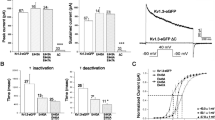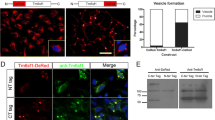Abstract
Mammalian Na+/H+ exchanger (NHE) isoform NHE6 is localized in sorting/recycling endosomes, whereas NHE7 is localized in the trans-Golgi network (TGN) and mid-trans-Golgi stacks. The mechanism targeting each NHE to a specific organelle is largely unknown, although the targeting is thought to be important for pH control in the lumen of various organelles. NHE6 and NHE7 exhibit distinct localization despite conserved amino acid sequences. To specify the intramolecular region involved in the specific localization, we examined the intracellular localization of chimeric NHE6 and NHE7 constructs. NHEs are composed of an N-terminal transmembrane domain (TM) and a C-terminal hydrophilic tail domain (Ct). Exchange of the Ct between the isoforms suggested that the Ct is required for the specific localization. We further split the Ct into three regions, and chimeras with various combinations of these small regions indicated that the most membrane-proximal region among the three contributes to the specific localization. Mutant forms of NHE7 with sequential alanine substitutions in the most membrane-proximal region, between residues 530 and 589, showed that two regions (residues 553–559 and 563–568) are required for NHE7-like localization. However, NHE6 with alanine substitutions in the membrane-proximal region exhibited no apparent change in localization. These results suggest that two membrane proximal regions (residues 533–559 and 563–568) play an important role in targeting NHE7 to the TGN.







Similar content being viewed by others
References
Attaphitaya S, Park K, Melvin JE (1999) Molecular cloning and functional expression of a rat Na+/H+ exchanger (NHE5) highly expressed in brain. J Biol Chem 274:4383–4388
Baird NR, Orlowski J, Szabo EZ, Zaun HC, Schultheis PJ, Menon AG, Shull GE (1999) Molecular cloning, genomic organization, and functional expression of Na+/H+ exchanger isoform 5 (NHE5) from human brain. J Biol Chem 274:4377–4382
Becker AM, Zhang J, Goyal S, Dwarakanath V, Aronson PS, Moe OW, Baum M (2007) Ontogeny of NHE8 in the rat proximal tubule. Am J Physiol 293:F255–F261
Bonifacino JS, Traub LM (2003) Signals for sorting of transmembrane proteins to endosomes and lysosomes. Annu Rev Biochem 72:395–447
Brett CL, Wei Y, Donowitz M, Rao R (2002) Human Na+/H+ exchanger isoform 6 is found in recycling endosomes of cells, not in mitochondria. Am J Physiol 282:C1031–C1041
Carnell L, Moore HPH (1994) Transport via the regulated secretory pathway in semi-intact PC12 cells: role of intra-cisternal calcium and pH in the transport and sorting of secretogranin II. J Cell Biol 127:693–705
Chen HJ, Yuan J, Lobel P (1997) Systematic mutational analysis of the cation-independent mannose 6-phosphate/insulin-like growth factor II receptor cytoplasmic domain—an acidic cluster containing a key aspartate is important for function in lysosomal enzyme sorting. J Biol Chem 272:7003–7012
Cosson P, Decurtis I, Pouyssegur J, Griffiths G, Davoust J (1989) Low cytoplasmic pH inhibits endocytosis and transport from the trans-Golgi network to the cell surface. J Cell Biol 108:377–387
Duc-Nguyen H, Rosenblum EN, Zeigel RF (1966) Persistent infection of a rat kidney cell line with Rauscher murine leukemia virus. J Bacteriol 92:1133–1140
Fafournoux P, Noel J, Pouyssegur J (1994) Evidence that Na+/H+ exchanger isoforms NHE1 and NHE3 exist as stable dimers in membranes with a high degree of specificity for homodimers. J Biol Chem 269:2589–2596
Gluzman Y (1981) SV40-transformed simian cells support the replication of early SV40 mutants. Cell 23:175–182
Goyal S, Heuvel GV, Aronson PS (2003) Renal expression of novel Na+/H+ exchanger isoform NHE8. Am J Physiol 284:F467–F473
Goyal S, Mentone S, Aronson PS (2005) Immunolocalization of NHE8 in rat kidney. Am J Physiol 288:F530–F538
Hillerehfeld A (1995) Mannose 6-phosphate receptors in sorting and transport of lysosomal enzymes. Biochim Biophys Acta 1241:177–194
Inoue S, Tsuboi Y, Kanazawa H (2001) Chimeric Na+/H+ antiporters constructed from NhaA of Helicobacter pylori and Escherichia coli: implications for domains of NhaA for pH sensing. J Biochem 129:569–576
Lin PJC, Williams WP, Luu Y, Molday RS, Orlowski J, Numata M (2005) Secretory carrier membrane proteins interact and regulate trafficking of the organellar (Na+, K+)/H+ exchanger NHE7. J Cell Sci 118:1885–1897
Lin PJC, Williams WP, Kobiljski J, Numata M (2007) Caveolins bind to (Na+, K+)/H+ exchanger NHE7 by a novel binding module. Cell Signal 19:978–988
Matsumoto M, Miyake Y, Nagita M, Inoue H, Shitakubo D, Takemoto K, Ohtsuka C, Murakami H, Nakamura N, Kanazawa H (2001) A serine/threonine kinase which causes apoptosis-like cell death interacts with a calcineurin B-like protein capable of binding Na+/H+ exchanger. J Biochem 130:217–225
Matsushita M, Sano Y, Yokoyama S, Takai T, Inoue H, Mitsui K, Todo K, Ohmori H, Kanazawa H (2007) Loss of calcineurin homologous protein-1 in chicken B lymphoma DT40 cells destabilizes Na+/H+ exchanger isoform-1 protein. Am J Physiol 293:C246–C254
Murtazina R, Booth BJ, Bullis BL, Singh DN, Fliegel L (2001) Functional analysis of polar amino-acid residues in membrane associated regions of the NHE1 isoform of the mammalian Na+/H+ exchanger. Eur J Biochem 268:4674–4685
Nakamura N, Tanaka S, Teko Y, Mitsui K, Kanazawa H (2005) Four Na+/H+ exchanger isoforms are distributed to Golgi and post-Golgi compartments and are involved in organelle pH regulation. J Biol Chem 280:1561–1572
Numata M, Orlowski J (2001) Molecular cloning and characterization of a novel (Na+, K+)/H+ exchanger localized to the trans-Golgi network. J Biol Chem 276:17387–17394
Ohgaki R, Fukura N, Matsushita M, Mitsui K, Kanazawa H (2008) Cell surface levels of organellar Na+/H+ exchanger isoform 6 are regulated by interaction with RACK1. J Biol Chem 283:4417–4429
Ohgaki R, Matsushita M, Kanazawa H, Ogihara S, Hoekstra D, van Ijzendoorn SC (2010) The Na+/H+ exchanger NHE6 in the endosomal recycling system is involved in the development of apical bile canalicular surface domains in HepG2 Cells. Mol Biol Cell 21:1293–1304
Orlowski J, Grinstein S (2004) Diversity of the mammalian sodium/proton exchanger SLC9 gene family. Pfluegers Arch 447:549–565
Orlowski J, Kandasamy RA, Shull GE (1992) Molecular cloning of putative members of the Na/H exchanger gene family. cDNA cloning, deduced amino acid sequence, and mRNA tissue expression of the rat Na/H exchanger NHE-1 and two structurally related proteins. J Biol Chem 267:9331–9339
Perret E, Lakkaraju A, Deborde S, Schreiner R, Rodriguez-Boulan E (2005) Evolving endosomes: how many varieties and why? Curr Opin Cell Biol 17:423–434
Sardet C, Franchi A, Pouyssegur J (1989) Molecular cloning, primary structure, and expression of the human growth factor-activatable Na+/H+ antiporter. Cell 56:271–280
Tse CM, Levine SA, Yun CHC, Montrose MH, Little PJ, Pouyssegur J, Donowitz M (1993) Cloning and expression of a rabbit cDNA encoding a serum-activated ethylisopropylamiloride-resistant epithelial Na+/H+ exchanger isoform (NHE-2). J Biol Chem 268:11917–11924
Wakabayashi S, Pang T, Su X, Shigekawa M (2000) A novel topology model of the human Na+/H+ exchanger isoform 1. J Biol Chem 275:7942–7949
Wan L, Molloy SS, Thomas L, Liu GP, Xiang Y, Rybak SL, Thomas G (1998) PACS-1 defines a novel gene family of cytosolic sorting proteins required for trans-Golgi network localization. Cell 94:205–216
Xu H, Chen R, Ghishan FK (2005) Subcloning, localization, and expression of the rat intestinal sodium-hydrogen exchanger isoform 8. Am J Physiol 289:G36–G41
Acknowledgements
This study was supported by a Grant-in-Aid for Scientific Research from the Ministry of Education, Culture, Sports, Science and Technology of Japan.
Author information
Authors and Affiliations
Corresponding author
Electronic supplementary material
Below is the link to the electronic supplementary material.
Supplemental Fig. 1
Alignment of amino acid sequences of human NHE6 and NHE7. The boundary between the N-terminal transmembrane domain (TM) and the C-terminal hydrophilic domain (Ct) is denoted by a vertical line with arrows. Split regions (A, B and C) in Ct are indicated with boxes. The binding sites of RACK1 and SCAMP2 are also shown with light blue and purple lines, respectively. The YXXΦ-like sequence in NHE7 is shown with a red line (PDF 241 kb)
Rights and permissions
About this article
Cite this article
Fukura, N., Ohgaki, R., Matsushita, M. et al. A Membrane-Proximal Region in the C-Terminal Tail of NHE7 Is Required for Its Distribution in the Trans-Golgi Network, Distinct from NHE6 Localization at Endosomes. J Membrane Biol 234, 149–158 (2010). https://doi.org/10.1007/s00232-010-9242-9
Received:
Accepted:
Published:
Issue Date:
DOI: https://doi.org/10.1007/s00232-010-9242-9




